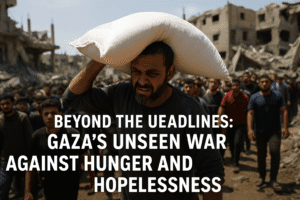Beyond the Headlines: Gaza’s Unseen War Against Hunger and Hopelessness
Palestinian civilians in Gaza face deadly peril simply seeking food, with Israeli fire reportedly killing at least 18 people Saturday – including eight near aid sites – amid a catastrophic hunger crisis. Health officials report mounting malnutrition deaths, including 93 children since the war began. Desperate crowds describe becoming targets despite posing no threat, calling it a grim daily reality. Simultaneously, hostage families in Tel Aviv protest, distraught over newly released videos showing emaciated captives and demanding government action for their release.
International efforts to alleviate starvation, like costly airdrops, are widely condemned as insufficient theater while Israel restricts vital overland aid, blocking safer, more effective delivery. The UN cites hundreds killed near aid distribution points since May, contradicting denials from Israeli forces and contractors. Civilians are trapped between risking death for sustenance or succumbing slowly to hunger, as the conflict devastates basic humanity and security on both sides of the divide.

Beyond the Headlines: Gaza’s Unseen War Against Hunger and Hopelessness
The scene near the Gaza Humanitarian Foundation (GHF) distribution site on Saturday wasn’t an anomaly; it was a grim ritual. Yahia Youssef’s exhausted words – “It’s the same daily episode” – capture the soul-crushing reality for Palestinians trapped between starvation and Israeli fire. His actions, helping carry wounded victims amidst panicked crowds, are now tragically routine.
The Human Cost of a “Worst-Case Scenario”:
- Death While Seeking Sustenance: Health officials report at least 18 Palestinians killed by Israeli strikes and gunfire Saturday. Crucially, eight were food-seekers near aid sites. Abed Salah, who narrowly escaped, insists crowds posed no threat: “We weren’t close to them (the troops)… I escaped death miraculously.”
- The Silent Killer: Malnutrition: While bullets claim lives instantly, starvation works slowly. Seven Palestinians, including a child, died of malnutrition-related causes in the past 24 hours. Since the war began, 93 children and 76 adults have perished this way – preventable deaths highlighting the catastrophic aid blockade.
- A System in Collapse: The UN report citing 859 deaths near GHF sites since late May underscores the lethal environment surrounding aid delivery. Eyewitness accounts consistently describe Israeli fire targeting crowds, contradicting GHF’s claim that only “pepper spray or warning shots” were used and Israel’s assertion of firing only “warning shots.” The result is a paralyzing choice: risk death for food or face slow starvation.
The Echoing Cries from Tel Aviv: While Gaza burns, desperation simmers in Israel. Families of hostages protested in Tel Aviv, confronted by newly released Hamas videos showing emaciated captives like 21-year-old Rom Braslavski. His mother’s plea – “They broke my child. I want him home now… Look at him: Thin, limp, crying” – mirrors the anguish in Gaza, a stark reminder of the war’s dual devastation. Former U.S. envoy Steve Witkoff joined them, abandoning ceasefire talks but pledging alternative efforts, while protesters implored the government: “stop this nightmare and bring them out of the tunnels.”
The Futile Gestures and the Blocked Path: International responses remain tragically inadequate:
- Airdrops: A Costly Illusion: While European nations join Jordan-led airdrops, UNRWA chief Philippe Lazzarini bluntly stated: “If there is political will to allow airdrops — which are highly costly, insufficient & inefficient, there should be similar political will to open the road crossings.” Airdrops are a symbolic bandage on a hemorrhaging wound, incapable of meeting Gaza’s vast needs.
- The Root Failure: Israel’s near-total restriction on overland aid, justified by unsubstantiated claims of Hamas diversion despite UN safeguards, remains the core obstacle. The collapse of Hamas-led police escorts, previously ensuring some convoy safety, has plunged aid distribution into deadly chaos. The once-functional UN delivery mechanism is now crippled.
The Unseen War: This conflict extends beyond rockets and rifles. It’s a war against:
- Human Dignity: Reducing people to desperate crowds fighting for flour sacks.
- Basic Survival: Where seeking food becomes a potentially fatal act.
- Accountability: Where denials (GHF: “nothing happened”) clash with mounting eyewitness testimony and body counts.
- Hope: For hostage families seeing their loved ones waste away, and for Gazans watching their children succumb to hunger.
Youssef’s “daily episode” isn’t just violence; it’s the normalization of a profound humanitarian collapse. The flour sacks carried through Beit Lahiya’s ruins symbolize not just sustenance, but the crushing weight of a conflict where the most fundamental human needs – food and safety – are weaponized or denied. Until overland aid flows freely and safely, and until political will prioritizes human life over military objectives, this devastating cycle of death by bullet and death by hunger will continue, etching its tragedy into Gaza’s exhausted landscape. The real battle being lost is one for basic humanity.
You must be logged in to post a comment.